
31 minute read
Layer 4: Resilient Infrastructure
from Climate Ready Boston
by Sasaki
EXPOSURE
POPULATION & INFRASTRUCTURE
CHARLES RIVER POPULATION EXPOSURE POPULATION & SOCIAL VULNERABILITIES
Residents of the Charles River neighborhoods comprise about 22 percent of Boston’s overall population, or about 142,000 people. The Charles River neighborhoods are relatively affl uent compared to the city as a whole; it has just one public housing development and 25 percent of the population in low- to no-income categories. Nevertheless, Back Bay and Beacon Hill have
among the highest percentage of people with a medical illness (42 percent) and older adults (12 percent) throughout Boston.
Shelter needs in the Charles River neighborhoods are expected to be around 200 individuals for the area for the low-probability (1 percent annual chance) event later this century. Seven public emergency shelters are located within the Charles River neighborhoods, with the capacity to shelter 1,000 individuals. Only the Boston Arts Academy shelter will be exposed to the 0.1 percent annual chance event, which has a capacity of 151. The remaining shelters are not expected to be exposed to fl ood impacts and may be able to shelter some residents from other neighborhoods in an event. Unexposed colleges, universities, and hospitals in the Charles River neighborhoods may be able to provide shelter as well.
INFRASTRUCTURE
Transportation systems within the Charles River neighborhoods are not likely exposed to coastal fl ooding and sea level rise until later in the century. Even so, major impacts are only expected for low-probability events.
2Based on 2014 MBTA ridership and service statistics. Number only captures station entries and does not include all passengers traveling on the line as is passes through the station. As soon as the 2050s, parts of Storrow Drive are expected to be exposed to low-probability storms. Later in the century, additional sections of Storrow Drive, as well as sections of Beacon Street and River Street in Back Bay and Beacon Hill, may be impacted by low-probability fl ood events (1 percent chance). Flooding along these roads will not only impact safe evacuation from the area, but potential damage and traffi c interruptions may also aff ect crosstown connections and quick access to Downtown. Delivery of resources such as food supplies and research materials may also be disrupted in the case of fl ooded roads surrounding the campuses, in addition to student commutes to Boston University, Harvard’s Business School and Stadium, and the Soldiers Field athletic area. Very low-probability fl ood events (0.1 percent annual chance) later in the century have the potential to impact Mass Pike, which may further limit transportation connections Downtown. Portions of MBTA’s Green Line within Back Bay and Beacon Hill, including the Arlington and Prudential T Stations, are exposed to fl ood impacts later in the century. The Green Line runs at grade for much of the western portion of its route and also has the potential to be interrupted by stormwater fl ooding between Packard’s Corner and Harvard Avenue Stations. Service interruptions at the aforementioned stations could result in over 12,000 daily riders2 needing alternative transportation, especially aff ecting those who use the Green Line to commute from Boston’s inland neighborhoods to Downtown. Expected impacts to transportation patt erns will grow signifi cantly with a 0.1 percent chance event later in the century. Green Line exposure will extend from Back Bay and Beacon Hill into Fenway/Kenmore, while Red Line connections from Back Bay and Beacon Hill to Cambridge may also be aff ected by fl ooding. Charles River emergency response assets are not expected to be exposed to fl ood impacts this century. Areas adjacent to the Charles River neighborhoods with emergency response facilities exposed to coastal fl ood damage include Downtown, the South End, and northern Roxbury. If emergency response facilities in these areas are impacted by fl ooding, fi re, police, and EMS stations in the Charles River neighborhoods may be called upon for support, in which case capacity, response times, and transportation routes between neighborhoods must be bett er understood.
Very low-probability events expected later in the century may impact many colleges and universities in the Charles River neighborhoods; colleges and universities provide the second-largest number of jobs in the area.
The Charles River neighborhoods are home to many well-known colleges and universities, including Boston University, portions of Harvard and Northeastern University, and other institutions associated with the Longwood Medical Area such as Simmons College and Emmanuel College. All of the aforementioned campuses have at least some portion exposed to the 0.1 percent chance event per the statistical expectation later in the century. Damages to campus assets or roads may not only disrupt class schedules and aff ect research, but the area’s economy may suff er if there is prolonged interruption in operations. Site-specifi c reviews of each college and university asset are required to assess expected impacts.
EXPOSURE AND CONSEQUENCES
BUILDINGS AND ECONOMY
RISK TO BUILDINGS
The Charles River neighborhoods are generally less exposed than other Climate Ready Boston focus areas in the near term and throughout the midcentury. Nevertheless, without mitigation, impacts may still be expected, particularly for the lower-probability fl ood events later this century. The Charles River neighborhoods are not expected to experience structure and content damage until mid-century. Even so, damages may be comparatively low when considering impacts in other focus areas. As soon as the 2050s, approximately $13,000 in annualized structure and content losses are expected under the lowprobability (1 percent annual chance) event. Midcentury losses are expected to be concentrated along the Charles River Esplanade. Structures exposed in the Charles River neighborhoods increase signifi cantly from the 1 percent annual chance event (low probability) to the 0.1 percent annual chance event (very low probability) later in the century. Overall, nearly $15 million in annualized structure and contents losses could be expected as soon as the 2070s.
CHARLES RIVER REAL ESTATE MARKET VALUE EXPOSED CHARLES RIVER BUILDING EXPOSURE
In the second half of the century, approximately 700 structures are expected to be exposed to the low-probability fl ood event (1 percent annual chance), with $4 million expected in annualized structure and contents losses. Most of these losses may be concentrated in Back Bay, with over 60 structures expected to be impacted in Allston and less than ten in Fenway. Very low-probability fl ood events (0.1 percent annual chance) expected as soon as the 2070s may present signifi cant risk, with nearly 3,640 structures expected to be exposed. Considering all storm frequencies analyzed, nearly $15 million in annualized structure and contents losses are expected in the late century.

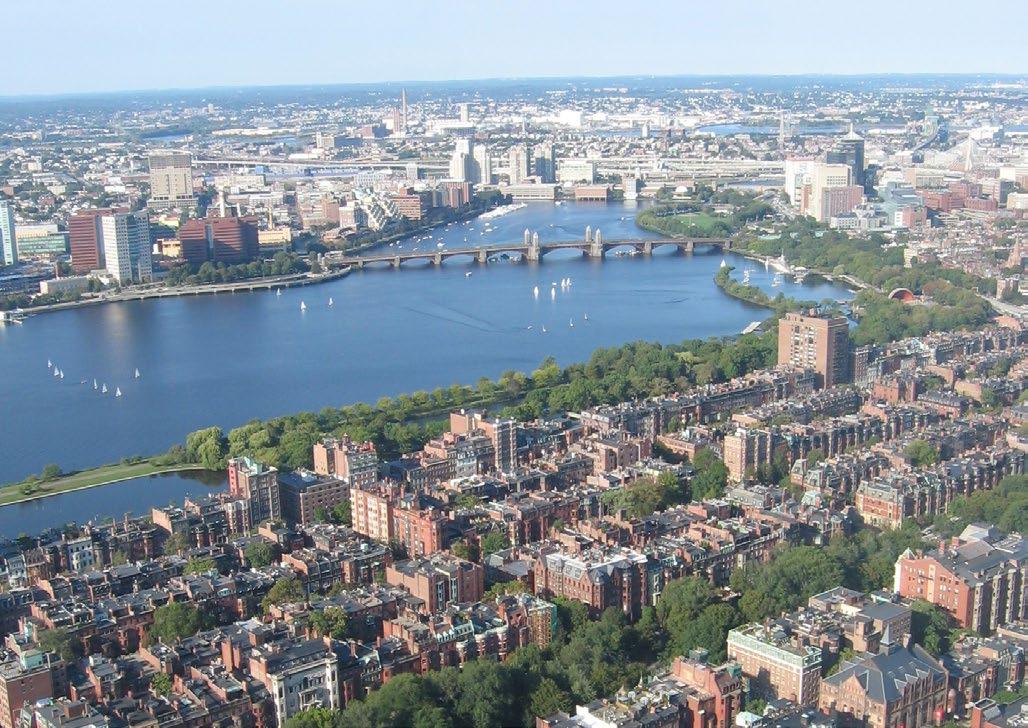
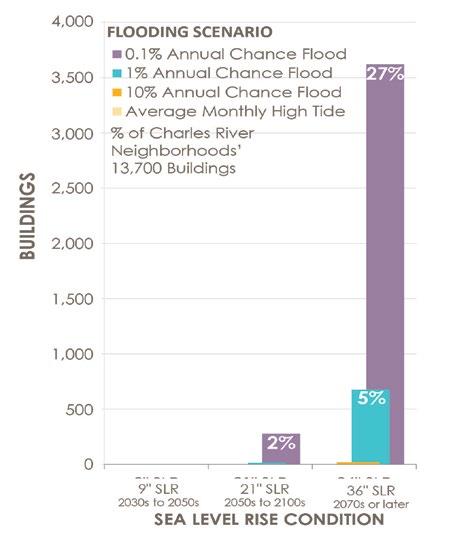
Image courtesy of Sasaki
The Charles River neighborhoods contribute over 237,000 jobs and $46 billion in annual output (sales and revenues) to the Boston economy. Top industries in terms of employment are hospitals, restaurants, and colleges, universities, and professional schools due to the presence of the Longwood Medical Area and large institutions. Hospitals, real estate, insurance, and fi nancial investment activities are the area’s current topproducing industries when considering sales and revenues. In contrast to South Boston, many
of the area’s top industries are vulnerable to business interruption, as it is extremely diffi cult for many large institutions to operate remotely or relocate operations quickly in the
event of a coastal storm. Nevertheless, business interruption is not expected in the Charles River neighborhoods in the near-term, and mid-century business interruption is limited in comparison to other focus areas, though not insubstantial. In the second half of the century, the Charles River neighborhoods can expect close to $90,000 in annualized output losses due to expected fl ood damage to structures.3 As soon as the 2070s, annualized output losses as a result of business interruption are expected to be around $6.3 million with approximately 40 annualized jobs lost. These estimates include interruption from businesses directly exposed to fl ood impacts, as well as the reverberations that impact may have throughout Suff olk County’s economy.4
Industries expected to be most aff ected are the performing arts, restaurants, and entertainment and recreational facilities, likely due to the exposure at the Soldiers Field Athletic Area and other entertainment industries present along the Charles River.
CHARLES RIVER ECONOMIC LOSSES
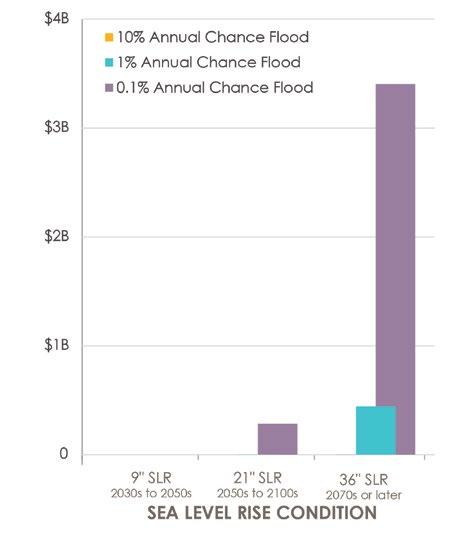
CHARLES RIVER ANNUALIZED LOSSES ECONOMIC RISK ASSUMPTIONS
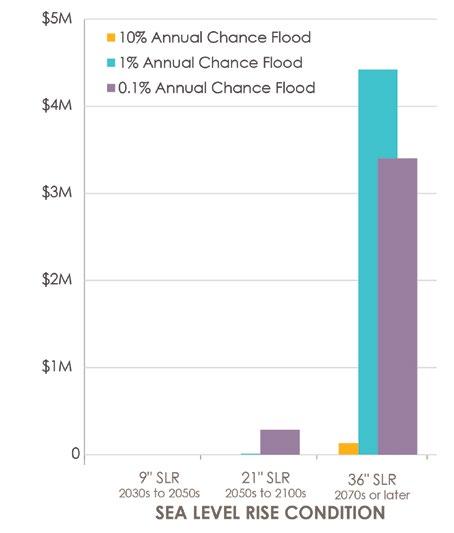
Job and output loss includes direct, indirect, and induced consequences of flood impacts. Direct results are impacts felt within a neighborhood, while indirect and induced results are those expected to be felt throughout Suffolk County as a result of changes in spending patterns. Results for both job and output losses are the sum of annualized values for the four flood frequencies analyzed for each sea level rise scenario. This represents a lower-bound estimate for several reasons. First, not all probabilistic events are considered. Second, the analysis assumes that all impacted businesses eventually reopen, though FEMA estimates that almost 40 percent of small businesses—and up to 25 percent of all businesses—never reopen after experiencing flood impacts. Third, only building areas directly impacted by floodwater are assumed to experience business interruption. This does not consider interruptions of businesses due to loss of power or utility functions. Finally, the analysis only considers existing populations, businesses, and buildings and does not include projections for future growth. Refer to the Appendix for a more detailed explanation of the exposure and consequence analysis.
INDUSTRY
Performers and Performing Arts Companies
Restaurants
Entertainment and Recreational Facilities, including sports centers, museums, and parks
Real Estate
ANNUALIZED LOSS OF ECONOMIC OUTPUT
$ 1,000,000
$ 630,000
$ 940,000
$ 730,000
All other industries
Total
$ 2,900,000
$ 6,300,000
3 Expected fl ood damages are calculated for the 10%, 2%, 1%, and 0.1% annual chance fl ood events only.
4 Losses to particular industries are based on current development and economic activity in the area, and considering that South Boston is in a period of intense growth, may differ as development continues.
EXPECTED ANNUALIZED LOSSES TO STRUCTURES AND CONTENTS
36 INCHES OF SEA LEVEL RISE AT 10%, 2%, 1%, 0.1% ANNUAL CHANCE COASTAL FLOOD EVENTS.
CHARLES RIVER ANNUALIZED LOSSES 36 INCH SEA LEVEL RISE CONDITION

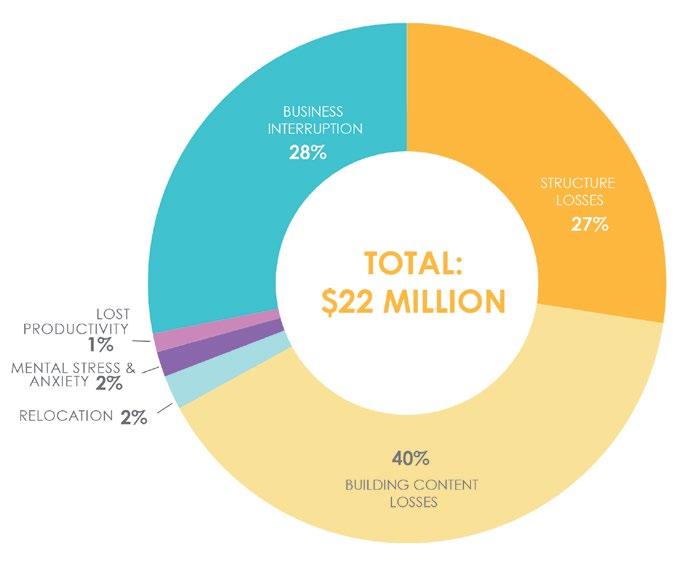
Probable annualized losses are based on generalized assumptions, as opposed to site-specifi c assessment of structures. Site-specifi c evaluations of vulnerability are beyond the scope of this assessment and should be reserved for detailed evaluation of specifi c resilience initiatives or a next phase of this project.
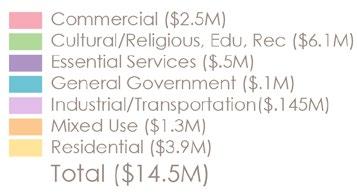

Each circle represents annualized losses suffered by an individual building. Larger circle size indicates higher contents and structures losses. Annualized losses take into consideration the annual probability of an event occurring, as well as the projected impacts of such an event.
CHARLES RIVER NEIGHBORHOODS
APPLICATION OF RESILIENCE INITIATIVES
PROTECTED SHORES To reduce the risk of coastal fl ooding at major inundation points, the City should study the feasibility of PRIORITIZE AND STUDY THE constructing district-scale fl ood protection at the primary
FEASIBILITY OF DISTRICT-
SCALE FLOOD PROTECTION fl ood entry points for the Charles River neighborhoods (see Potential Flood Protection Locations below for a preliminary identifi cation of locations and potential benefi ts). As described below, fl ood protection systems that would benefi t these neighborhoods would likely be located by the New Charles River Dam, in South Boston, and in Dorchester. These feasibility studies should feature engagement with local community stakeholders, coordination with infrastructure adaptation, and considerations of how fl ood protection would impact or be impacted by neighborhood character and growth. Examples of prioritization criteria include the timing of fl ood risk, consequences for people and the economy, social equity, fi nancial feasibility, and potential for additional benefi ts beyond fl ood risk reduction.

POTENTIAL DISTRICT-SCALE FLOOD PROTECTION LOCATIONS 5
See District-Scale Flood Protection Systems section for a citywide perspective on district-scale fl ood protection. District-scale fl ood protection is only one piece of a multilayered solution that includes prepared and connected communities, resilient infrastructure, and adapted buildings.
5 These preliminary coastal fl ood protection concepts are based on a high-level analysis of existing topography, rights-of-way, and urban and environmental conditions. Important additional factors, including existing drainage systems, underground transportation and utility structures, soil conditions, zoning, as well as any potential external impacts as a result of the project have not been studied in detail. As described in Initiatives 5-2 and 5-3, detailed feasibility studies, including appropriate public and stakeholder engagement, are required in order to better understand the costs and benefi ts of fl ood protection in each location.
6 Additional fl ood protection may be required for fl ood events more severe than the 1% annual chance fl ood. See Appendix for more detailed information on expected effectiveness of fl ood protection systems, including analysis of additional fl ood protection locations and fl ood frequencies.
7 Benefi ts of district-scale fl ood protection would be modest.
8 While it is expected that fl ood protection that would not be independently effective would have some effect on fl ood loss, this effect could be positive or negative, and understanding the extent of the effect would require more detailed evaluation. As such, any benefi ts or costs above the identifi ed level of protection (the point beyond which the fl ood protection measure can no longer maintain independent effectiveness) have not been evaluated.
New Charles River Dam
In the near term, coastal and riverine fl ood risk along the Charles River is modest and likely does not require districtscale fl ood protection.
Later in the century, combined fl ood protection at multiple locations will become critical:
◦ At the New Charles River Dam, addressing potential overtopping or fl anking of the dam.
◦ At the South Boston Waterfront, addressing inland fl ood pathways originating from Fort Point Channel,
Boston Harbor, and the Reserve
Channel; and
◦ At Dorchester Bay, addressing inland fl ood pathways originating from the
Old Harbor and Savin Hill Cove.
SLR SCENARIO
9” SLR (2030s–2050s)
21” SLR (2050s–2100s)
36” SLR (2070s or later)
DISTRICT SCALE FLOOD PROTECTION FOR 1% ANNUAL CHANCE FLOOD6
None7
The New Charles River Dam
The New Charles River Dam, South Boston Waterfront, and Dorchester Bay Locations combined
South Boston Waterfront
Dorchester Bay
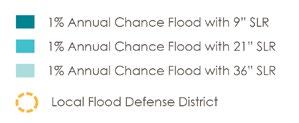
LOCATIONS ◦ The New Charles River Dam location, described in the Charles River and Downtown focus areas (see pp. 174, 216), addresses potential overtopping or fl anking of the dam. ◦ The South Boston Waterfront location, described in the South Boston focus area (see p.282), addresses fl ood entry points along the edge of the district. ◦ The Dorchester Bay location, described in the Dorchester focus area (see p.194), addresses fl ood pathways from the Old
Harbor and Savin Hill Cove. DETAILED CONSIDERATIONS ◦ Multiple neighborhoods protected:
The largest fl ood protection benefi t for neighborhoods along the Charles River comes from protection at the New Charles River
Dam. In addition, fl ood protection at the dam is expected to have near-term benefi ts for portions of Downtown and Charlestown. ◦ Need for multiple alignments late century:
Flood protection at the dam alone will not protect against late-century fl ooding from Fort
Point Channel, the Old Harbor, and Savin Hill
Cove, for which interventions at the South
Boston Waterfront and Dorchester Bay will be needed.
PREPARED & CONNECTED COMMUNITIES
CONDUCT AN OUTREACH CAMPAIGN TO PRIVATE FACILITIES THAT SERVE VULNERABLE POPULATIONS TO SUPPORT PREPAREDNESS AND ADAPTATION
EXPAND BOSTON’S SMALL BUSINESS PREPAREDNESS PROGRAM
In the long term, the City should conduct outreach to managers of facilities in the Charles River neighborhoods that serve signifi cant concentrations of vulnerable populations and are not required to have operational preparedness and evacuation plans under current regulations. Targeted facilities should include aff ordable housing complexes, substance abuse treatment centers, daycare facilities, food pantries, small nonprofi t offi ces, and others. The City should conduct outreach in the long term because there are no populations exposed under the 1 percent annual chance fl ood event until 36 inches of SLR, meaning that the Charles River neighborhoods has a longer adaptation window than other focus areas in the Boston. An illustrative example of the type of facilities to which the City could do outreach is the Bright Horizons Family Center, which will be exposed to damage later in the century.9
The City can reach out to small businesses in the Charles River neighborhoods exposed to stormwater fl ooding in the near term to help them develop business continuity plans, evaluate insurance coverage needs, and identify low-cost physical adaptations. The Charles River neighborhoods have roughly 160 commercial buildings exposed to stormwater fl ooding in the near term. In addition, the Brighton and the Allston Village Main Street Districts are expected to have isolated portions exposed to stormwater fl ooding in the near term and throughout the century. The Charles River neighborhoods do not have any small businesses exposed to coastal fl ooding during the 1 percent annual chance fl ood event with 9 inches of SLR.
9 The City did not review the extent of existing preparedness planning as part of this study.
RESILIENT INFRASTRUCTURE
ESTABLISH INFRASTRUCTURE COORDINATION COMMITTEE
PROVIDE GUIDANCE ON PRIORITY EVACUATION AND SERVICE ROAD INFRASTRUCTURE TO THE ICC
CONDUCT FEASIBILITY STUDIES FOR COMMUNITY ENERGY SOLUTIONS
The Infrastructure Coordination Committ ee (ICC) should support coordinated adaptation planning for Charlestown’s key infrastructure systems, including transportation, water and sewer, energy, telecommunications, and environmental assets. In the near term, the City should support the MBTA in conducting a full asset-level vulnerability assessment of its system. While the Charles River neighborhoods are not impacted by coastal and riverine fl ooding in the near term, fl ooding in Downtown Boston could reduce mobility for residents who depend on the Red, Green, and Orange Lines to access jobs and critical services in the area. In addition, in the later century under the 1 percent annual fl ood event, the Green Line will be exposed to coastal fl ooding, via the Arlington and Prudential Stations.
The Offi ce of Emergency Management should work with the Boston Transportation Department, Department of Public Works, and private utilities to provide guidance on critical roads to prioritize for adaptation planning, including those that are part of the City’s evacuation network and are required to restore or maintain critical services. In particular, Storrow Drive will be exposed at 9 inches of SLR under the 1 percent annual chance fl ood event. Storrow Drive is an important cross-town route that runs along the Charles River Esplanade, becoming Soldiers Field Road to the west and David G. Mugar Way to the east.
The 2016 Boston Community Energy Study identifi ed four sites in the Charles River neighborhoods as potential locations for emergency microgrids, based on their concentration of critical facilities. The Environment Department can work with local stakeholders and utility providers to explore these locations. Two of the sites, adjacent to Fenway Park and Northeastern University, are exposed to coastal and riverine fl ooding for very low-probability events (0.1 percent annual chance) expected later in the century, with minimal and isolated exposure to stormwater fl ooding in the near term.
ADAPTED BUILDINGS
PROMOTE CLIMATE READINESS FOR PROJECTS IN THE DEVELOPMENT PIPELINE
INCORPORATE FUTURE CLIMATE CONDITIONS INTO AREA PLANS AND ZONING AMENDMENTS
Upon amending the zoning code to support climate readiness (see Initiative 9-2, p.135), the Boston Planning and Development Agency (BPDA) should immediately notify all developers with projects in the development pipeline in the future fl oodplain that they may alter their plans in a manner consistent with the zoning amendments (e.g., elevating their fi rst-fl oor ceilings without violating building height limits), without needing to restart the BPDA permitt ing process. Currently, 121 residential and 45 commercial buildings are under construction or permitt ed in the Charles River neighborhoods, representing 4,511 additional housing units and 360,000 square feet of new commercial space.
The Boston Planning and Development Agency should incorporate future climate considerations (long-term projections for extreme heat, stormwater fl ooding, and coastal and riverine fl ooding) into major planning eff orts in the Charles River neighborhoods.
ESTABLISH A CLIMATE READY BUILDINGS EDUCATION PROGRAM FOR PROPERTY OWNERS, SUPPORTED BY A RESILIENCE AUDIT PROGRAM
REPARE MUNICIPAL FACILITIES FOR CLIMATE CHANGE
The City should develop and run a Climate Ready Buildings Education Program and a resilience audit program to inform property owners about their current and future climate risks and actions they can undertake to address these risks. A resilience audit should help property owners identify cost-eff ective, building-specifi c improvements to reduce fl ood risk, such as backfl ow preventers, elevation of critical equipment, and deployable fl ood barriers; promote interventions that address stormwater runoff or the urban heat island eff ect, such as green roofs or “cool roofs” that refl ect heat; and encourage owners to develop operational preparedness plans and secure appropriate insurance coverage. The resilience audit program should include a combination of mandatory and voluntary, market-based and subsidized elements.
To address extreme heat risks, the Offi ce of Budget Management should work with City departments to prioritize backup power installation at municipal facilities that demonstrate high levels of criticality, including Boston Centers for Youth and Family and Boston Public School facilities that serve as emergency shelters. An illustrative example of the type of facility that the City might prioritize to protect the power supply within the Charles River neighborhoods against heat impacts is the Jackson Mann Community Center.
Dorchester
Dorchester is the largest neighborhood in Boston in terms of both population and geographic area. It is bounded by South Boston to the north, Dorchester Bay to the east, the Neponset River to the south, and Mattapan and Roxbury to the west.
Dorchester was founded in 1630 and remained a predominately agricultural community for 200 years, although there was some waterfront industrial activity, especially in the Lower Mills area along the Neponset River and at Commercial Point. During the nineteenth century, Dorchester became a country retreat for wealthier Boston households, who built estates and second homes. In 1845, the Old Colony Railroad opened, with stations along Crescent Avenue (near the current JFK/U Mass Station), Savin Hill, and Harrison Square (near the current Fields Corner Station), thereby connecting Boston and Plymouth, Massachusett s. In 1870, Boston fully annexed Dorchester, and commercial and residential development accelerated. Supported by new streetcar and municipal water service, Dorchester’s population increased from only 12,000 residents in 1870 to 150,000 by the 1920s. From 1950 to 1980, Dorchester experienced disinvestment. In the 1950s, the Old Colony line was closed, and construction of the Southeast Expressway (I-93), which separated Dorchester’s residential areas to the west from the waterfront, was completed. In 1964, the Columbia Point public housing complex, which included approximately 1,500 low-income units, opened. By the 1980s, the complex was in such disrepair that it was turned over to a private fi rm for redevelopment. However, there was some modest institutional investment during this time period, with University of Massachusett s Boston Harbor Campus opening on Columbia Point in 1974 and the John F. Kennedy Presidential Library and Museum in 1979. Today, Dorchester consists of a number of distinct residential neighborhoods, anchored by commercial districts, including Uphams Corner, Fields Corner, and Codman Square. Dorchester has benefi tt ed from the recent expansion of the Fairmount Line, which runs from Downtown to Readville, with three new stations in Dorchester (Newmarket, Four Corners/Geneva Avenue, and Talbot Avenue). The City is planning transit-oriented development along the Fairmount Line. In addition, the University of Massachusett s Boston is planning a signifi cant expansion at Columbia Point on the former Bayside Exposition Center site.

FLOOD PROGRESSION
DEFINITIONS
Near term: Beginning 2030s, assumes 9 inches of sea level rise
Midterm: Beginning 2050s, assumes 21 inches of sea level rise
Long term: Beginning 2070s or later, assumes 36 inches of sea level rise
Exposure: Can refer to people, buildings, infrastructure, and other resources within areas likely to experience hazard impacts. Does not consider conditions that may prevent or limit impacts.
Vulnerability: Refers to how and why people or assets can be affected by a hazard. Requires site-specific information.
Consequence: Illustrates to what extent people or assets can be expected to be affected by a hazard, as a result of vulnerability and exposure. Consequences can often be communicated in terms of economic losses.
Annualized losses: The sum of the probability-weighted losses for all four flood frequencies analyzed for each sea level rise scenario. Probability-weighted losses are the losses for a single event times the probability of that event occurring in a given year.
*For a full list of definitions, refer to the Glossary in the Appendix.
In the second half of the century, large areas of Dorchester will be exposed to high-probability fl ooding (10 percent annual chance). During this time frame, coastal fl ooding in Dorchester will be most prominent from Dorchester Bay near Joseph Moakley Park and along the Neponset River.
Dorchester is exposed to climate change impacts including heat, increased precipitation and stormwater fl ooding, and sea level rise and coastal and riverine fl ooding. Exposure to heat and stormwater fl ooding are addressed in the Citywide Vulnerability Assessment (see p.12), while exposure and consequences to coastal and riverine fl ood risk are further discussed in this section In the near term and in the second half of the century, exposure to coastal fl ooding is primarily due to the low waterfront edge along Dorchester
LEGEND
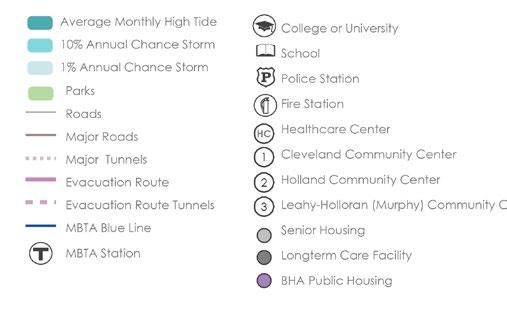
9 INCHES SEA LEVEL RISE 21 INCHES SEA LEVEL RISE 36 INCHES SEA LEVEL RISE
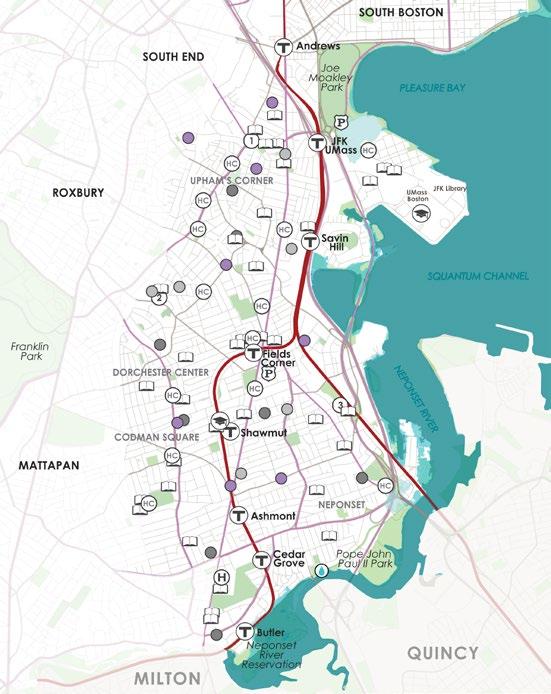


Bay and the Neponset River. Though exposure is largely limited in the near term, approximately 10 percent of the land areas in Dorchester have a high probability of fl ooding as soon as the 2050s (10 percent annual chance). Areas around Joseph Moakley Park are additionally exposed to lowprobability fl ood events (1 percent annual chance) as soon as the 2050s. In the late century, Dorchester exposure will change signifi cantly, with large areas exposed to high-probability fl ood events (10 percent annual chance). More critically, in the late century,
Northern Dorchester is expected to become a fl ood pathway to South Boston, the South End,
and Roxbury. Areas around Joseph Moakley Park, created using fi ll in the late 1800s, tend to be low lying, leading to the exposure in Dorchester and surrounding areas. The topography around Joseph Moakley Park and I-93 is low lying, potentially allowing fl oodwaters to propagate inland. Flood protection solutions targeted toward this area in northern Dorchester may provide benefi ts in South Boston, the South End, and Roxbury. The greatest concentration of land area exposed is on the northern end of Dorchester, due to coastal fl ooding from Dorchester Bay through Joseph Moakley Park.
In the late century, fl ooding from Dorchester Bay will extend from Dorchester into South Boston, the South End, and Roxbury.

EXPOSURE
POPULATION & INFRASTRUCTURE
POPULATION AND SOCIAL VULNERABILITIES
There are about 87,000 residents in Dorchester, about 14 percent of Boston’s overall population. In total, 24 percent of Dorchester households have children, compared to 17 percent citywide. Dorchester also has a diverse population that is 72 percent people of color, compared to 52 percent citywide. Approximately 6,820 people live in housing that is projected to be at risk in a low-probability fl ood scenario (1 percent annual chance) as soon as the 2070s, generating need for shelter beds for an estimated 750 individuals. Seven public emergency
DORCHESTER POPULATION EXPOSURE
shelters are located within Dorchester and have the capacity for 1,000 individuals. McCormick Middle School, located on Columbia Point, is northern Dorchester’s only emergency shelter, and as soon as the 2050s, it will be exposed to lowprobability fl ood events (1 percent annual chance). If this shelter is impacted by fl ooding, all roads leading out of Columbia Point are also expected to be fl ooded, potentially isolating residents in the northern portion of Dorchester without shelter. As soon as the 2070s, the Leahy Holloran Community Center will also be exposed to high-probability fl ood events (10 percent annual chance), which would reduce the shelter capacity by an additional 140 individuals.
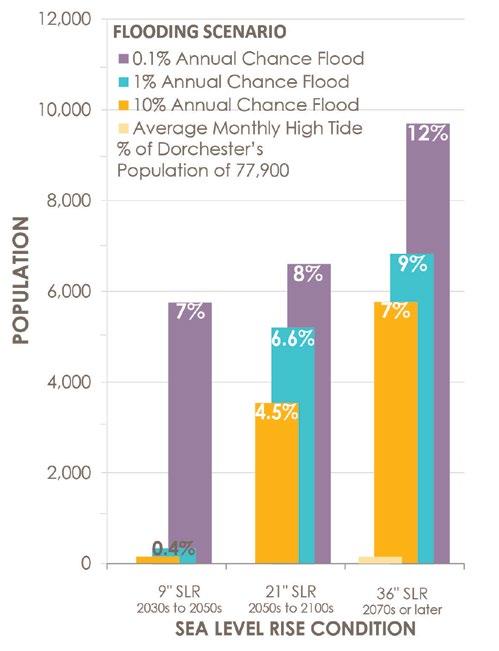
INFRASTRUCTURE
Damage to exposed roads and the MBTA Red Line could isolate Columbia Point from the rest of Dorchester and impact transportation connections to North Quincy. Within this century, all of Dorchester’s evacuation routes, including I-93 South, Morrissey Boulevard, Neponset Avenue, and Gallivan Boulevard, will be exposed to coastal fl ooding and sea level rise. In the near term, portions of Morrissey Boulevard near the Dorchester Bay Basin and the Neponset Avenue/I-93 South junction are exposed to highprobability fl ood events (1 percent annual chance). As soon as the 2050s, all of Morrissey Boulevard, as well as sections of I-93 South in the same area, will be exposed to high-probability fl ood events (10 percent annual chance). Road closures due to fl ood damage could isolate Columbia Point from the rest of Dorchester, impacting a major university (University of Massachusett s Boston) and three K–12 schools, aff ecting delivery of resources into the area, and aff ecting major transportation links between Downtown Boston, Dorchester, and the South Shore.
In the second half of the century, the MBTA Red Line JFK/UMass Station will be exposed to high-probability fl ood events, meaning that approximately 8,000 riders may need alternative transportation options. In addition, portions of the Fairmount commuter rail line in South Boston are exposed to high-probability storms, potentially limiting the transportation options of those who commute from Dorchester to South Boston or Downtown using this line. As soon as the 2070s, sections of the Fairmount line in northern Dorchester and the Newmarket Station will be exposed to fl ooding. Low- to no-income populations that might depend disproportionally on public transportation may also be disproportionally aff ected by the impacts for coastal fl ooding and sea level rise in the mid- to late century. Dorchester’s emergency response facilities are exposed to sea level rise and coastal fl ood impacts throughout the century. Private ambulance service providers have two facilities located in the Dorchester neighborhood. In the near term, one facility is exposed to fl ood impacts due to high-probability storms (10 percent annual chance). As soon as the 2050s, it will be exposed to monthly tides. If the station is damaged or has reduced response capacity, then the remaining station may be expected to cover the service area. As soon as the 2070s, the remaining station will become exposed to fl ooding from lowprobability events (1 percent annual chance). In the near term, the Boston State Police Station H-6 will be exposed to low-probability storm events, while the Engine 20 Fire Station will be exposed to high-probability storm events (10 percent annual chance) as soon as the 2070s and may require support from other stations in the neighborhood. Commercial Point is exposed to lowprobability storms in the near term. This is not expected to disrupt distribution of liquid natural gas to and from National Grid’s storage tank. Commercial Point, nested between Dorchester Bay and the Neponset River, is home to a liquid natural gas (LNG) storage tank, solar panels, and a commercial marina. National Grid’s LNG storage tank on Commercial Point is elevated to provide protection against storm surge and is not expected to be exposed to fl ood impacts this century. Though other portions of Commercial Point and surface roads that connect the plant inland are exposed to fl ooding in the near term, National Grid has operational contingencies and plans in place to keep the natural gas plant operational. The solar power–generating facility on Commercial Point is not expected to be exposed to coastal fl ooding during this century but may be at risk of wind damage during storm events.
EXPOSURE AND CONSEQUENCES
BUILDINGS AND ECONOMY
CC Image courtesy of dalecruse on Flickr
RISK TO BUILDINGS
In the near term, close to 170 structures in Dorchester can expect some level of fl ooding from a low-probability event (1 percent annual chance) leading to $6 million in annualized direct physical damage costs to structures and their contents. Loss is expected to be concentrated most heavily in commercial (including offi ce) and industrial uses. Exposure to high tide is also signifi cant, with over 30 structures exposed in the near term (about $11 million in real estate market value). As soon as the 2070s, close to 4,500 of Dorchester’s structures can expect some level of fl ooding from a low-probability event resulting in direct physical damage costs of $86 million. Over half of all annualized losses expected in the late century are att ributed to commercial and offi ce buildings averaging three stories tall.

In addition, close to 120 structures (close to $200 million in real estate market value) are expected to be exposed to high tide later in the century. Also expected to be exposed to high tide later in the century is the former Bayside Exposition Center, where University of Massachusett s Boston has planned expansion and redevelopment.
Close to 4,500 structures can expect some level of fl ooding from a low-probability event in the late century.
DORCHESTER BUILDING EXPOSURE
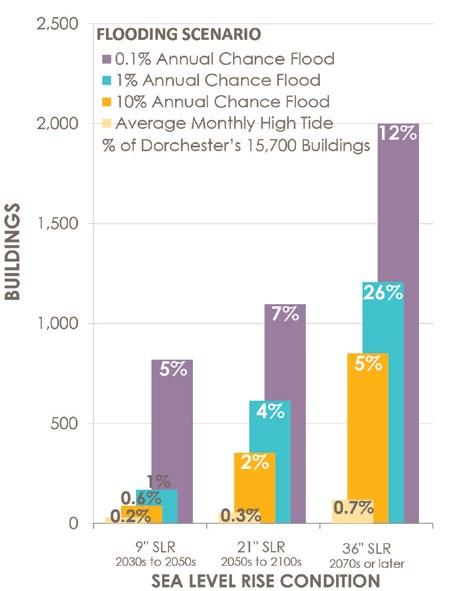
DORCHESTER MARKET VALUE EXPOSURE

Over $200 million in current real estate market value is expected to be exposed to high tides in the late century.
RISK TO THE ECONOMY1
Dorchester provides Boston with close to 35,000 jobs and over $7 billion in annual output. Top employers in the community include public education, hospitals, and grocers, though no one industry seems to dominate. The economy is heavily service oriented. As with other serviceoriented neighborhood economies, restaurants are expected to be most heavily impacted in a fl ood event, particularly considering expected loss of employment. This is expected to be the case throughout the century. As soon as the 2070s, coastal fl ood impacts to Dorchester are expected to result in 110 annualized jobs lost and about $15 million in annualized output loss to the current Boston economy. Restaurants are expected to comprise roughly 40 percent of job loss and 20 percent of output loss. Restaurants tend to employ low- to moderate-income personnel, and business interruption to such assets can exacerbate impacts to already vulnerable populations.
1 Economic data is provided at the zip code level. One of the South Dorchester zip codes overlaps with Mattapan. As such, the base economic data, and thus annual jobs and output production, for South Dorchester includes some of Mattapan. This is expected to have minimal impact on calculated results, which are based on average output and employment by industry per square foot within neighborhood zip codes.
ECONOMIC RISK ASSUMPTIONS
Job and output loss includes direct, indirect, and induced consequences of flood impacts. Direct results are impacts felt within a neighborhood, while indirect and induced results are those expected to be felt throughout Suffolk County as a result of changes in spending patterns. Results for both job and output losses are the sum of annualized values for the four flood frequencies analyzed for each sea level rise scenario. This represents a lower-bound estimate for several reasons. First, not all probabilistic events are considered. Second, the analysis assumes that all impacted businesses eventually reopen, though FEMA estimates that almost 40 percent of small businesses—and up to 25 percent of all businesses—never reopen after experiencing flood impacts. Third, only building areas directly impacted by floodwater are assumed to experience business interruption. This does not consider interruptions of businesses due to loss of power or utility functions. Finally, the analysis only considers existing populations, businesses, and buildings and does not include projections for future growth. Refer to the Appendix for a more detailed explanation of the exposure and consequence analysis.
INDUSTRY
Restaurants
Real Estate
Recreation facilities, including bowling centers, sports centers, and parks Wholesale trade and retail
All other industries
Total ANNUALIZED LOSS OF ECONOMIC OUTPUT
$3,200,000
$1,400,00
$790,000
$1,700,000
$7,900,000
$14,900,000 DORCHESTER ECONOMIC LOSSES
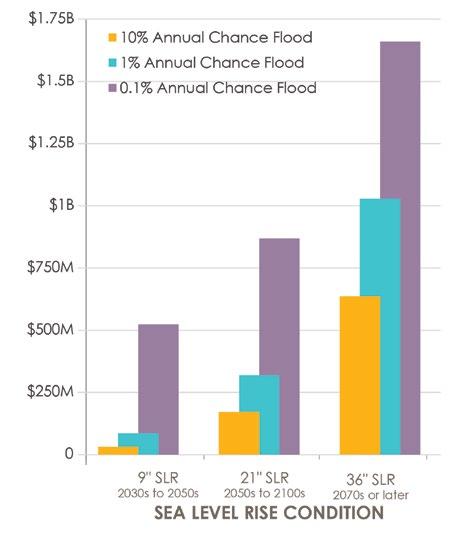
DORCHESTER ANNUALIZED LOSSES

Direct physical damages to structures are expected to be heavily concentrated in commercial and offi ce use buildings.
EXPECTED ANNUALIZED LOSSES TO STRUCTURES AND CONTENTS
36 INCHES OF SEA LEVEL RISE AT 10%, 2%, 1%, 0.1% ANNUAL CHANCE COASTAL FLOOD EVENTS.
DORCHESTER ANNUALIZED LOSSES 36 INCH SEA LEVEL RISE CONDITION
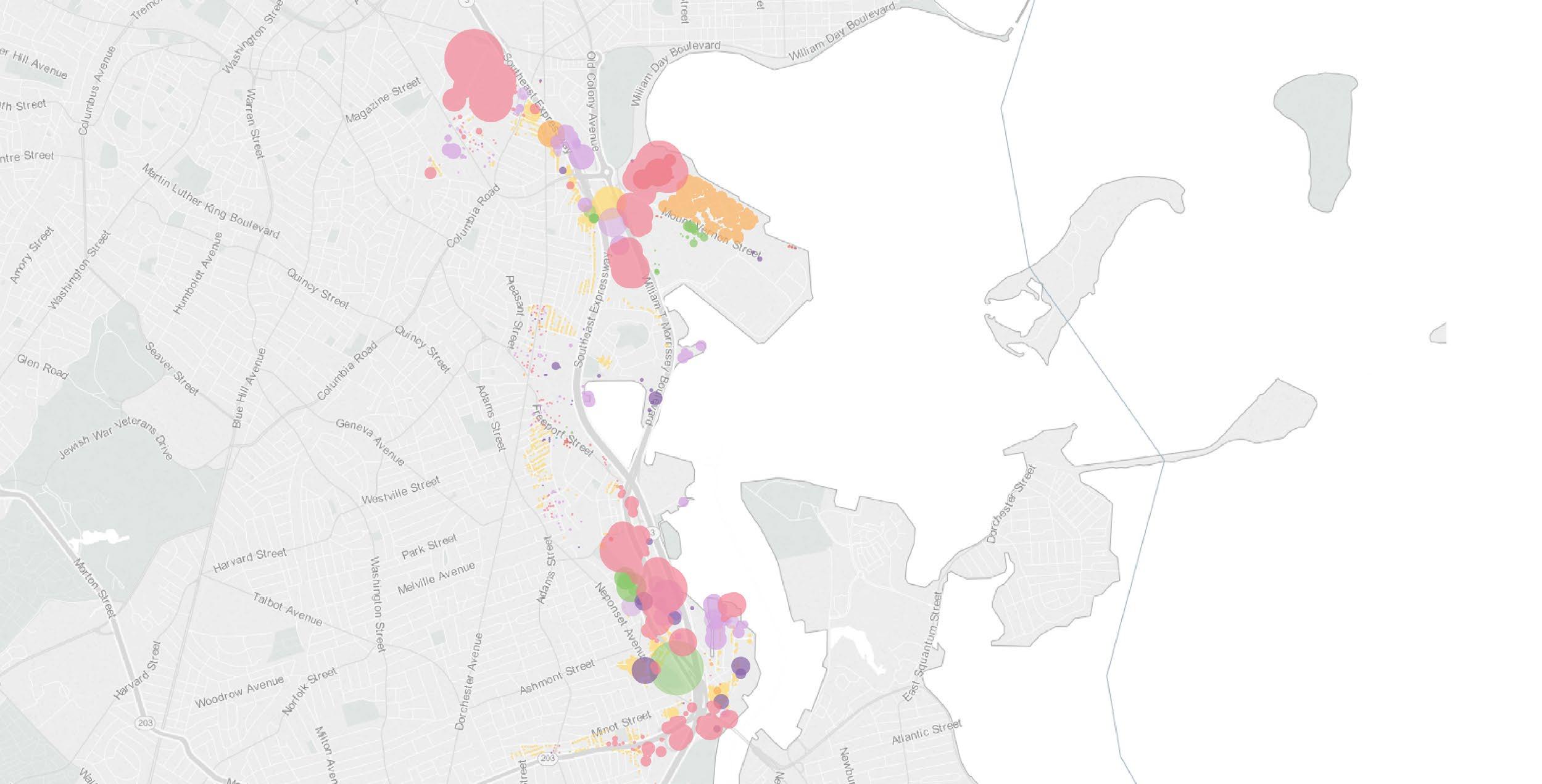
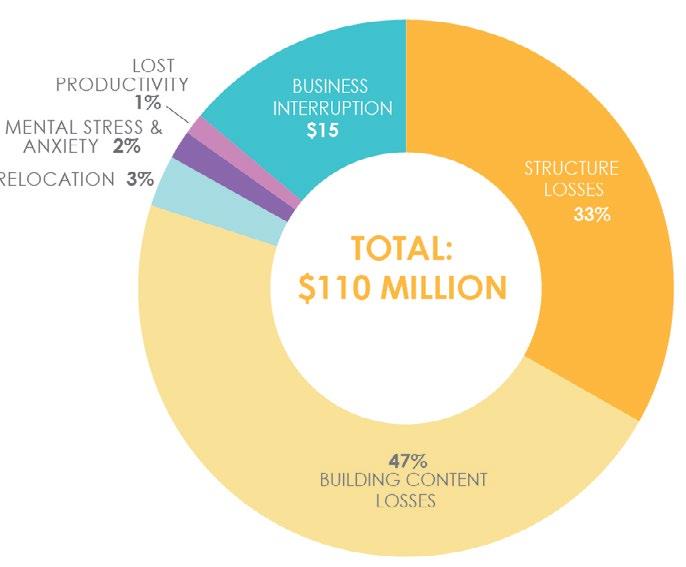
Probable annualized losses are based on generalized assumptions, as opposed to site-specifi c assessment of structures. Site-specifi c evaluations of vulnerability are beyond the scope of this assessment and should be reserved for detailed evaluation of specifi c resilience initiatives or a next phase of this project.
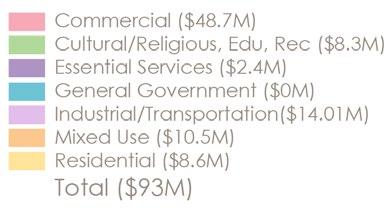

Each circle represents annualized losses suffered by an individual building. Larger circle size indicates higher contents and structures losses. Annualized losses take into consideration the annual probability of an event occurring, as well as the projected impacts of such an event.

